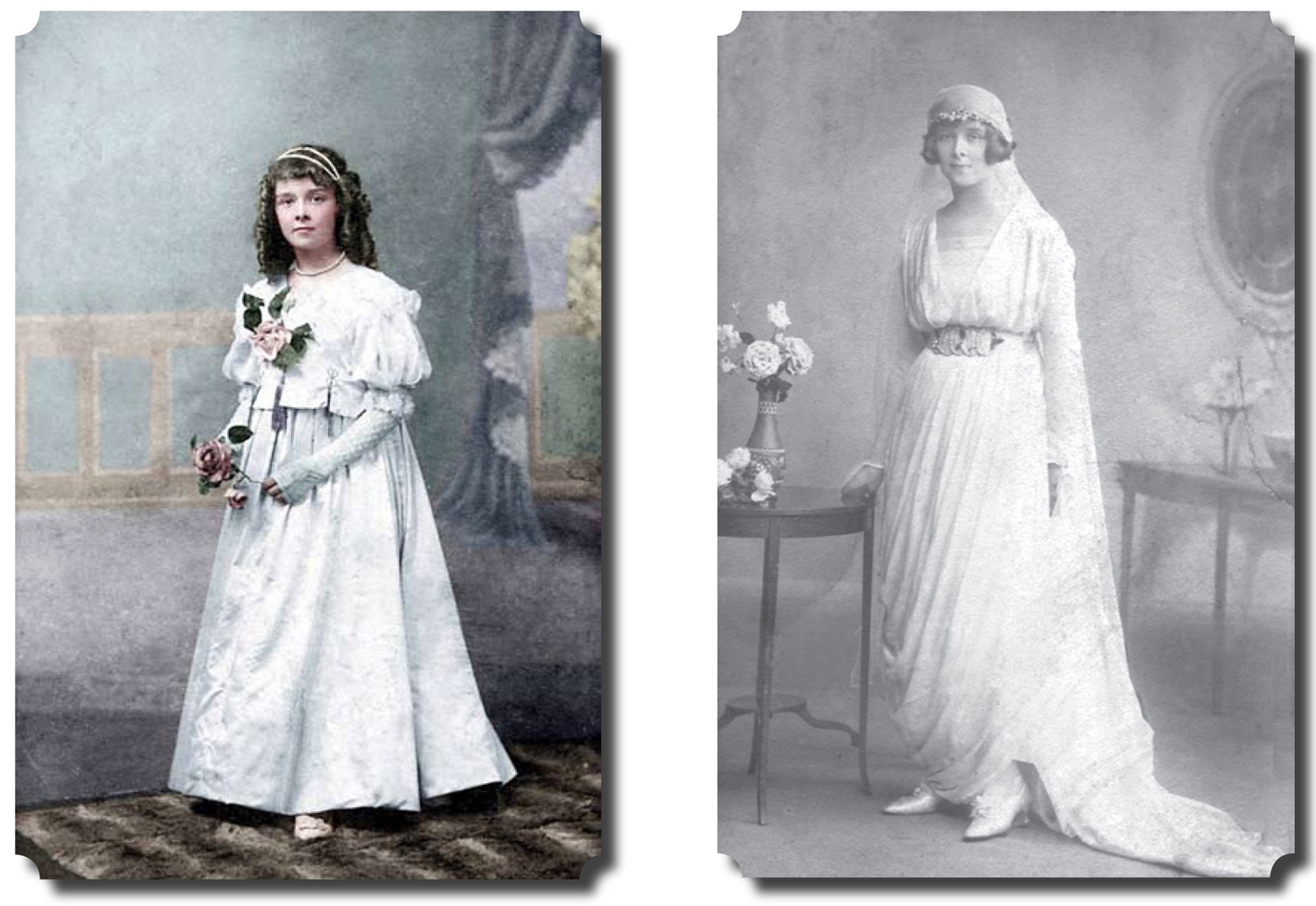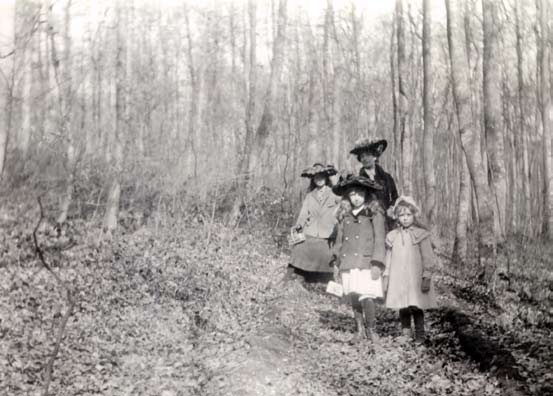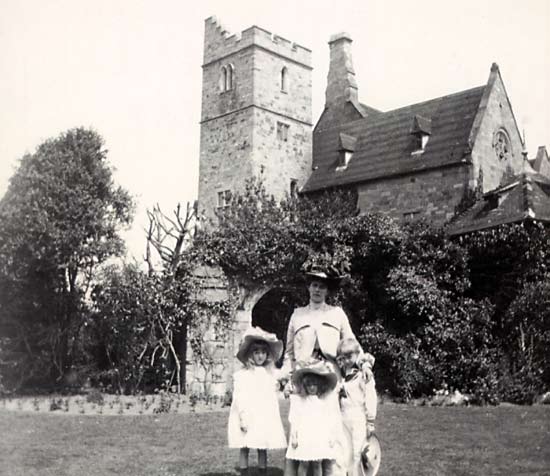GERTRUDE
(BUNNIE) KNOX (NEE COORE)
By Rosamund O'Brien

Rosamund is
the daughter of our grandmother's sister Monica b. 1897
Gertrude
Mary (Bunnie) Knox (nee Coore) was the fourth
child born to Augusta and George Barnard Milbank
Coore. She was born in London on February 4, 1899
and died on June 27, 1971 at Kyneton, Victoria, Australia.
Her sisters were Constance Araminta, born London 1892 and
died at Vermont, Dorset, on May 22, 1966; and Monica Augusta, born
London on May 8, 1897 and died May 23, 1966 at Croydon, Victoria,
Australia. She had one brother Edmund Burchardt
George born London 1894 and died 1958 in Sydney, NSW,
Australia.
My
mother
was always proud of the fact that never a cross word had
passed between the two all their lives. They were
closest in age and shared the nursery at 47 Egerton Gardens in
Kensington, London. Throughout the regular letters
of their lifetime they were addressed as 'Dearest
M' and 'Dearest B'.
Bunnie
was the aunt to whom I felt
closest. I knew her much better than any of my
father's six sisters although I did get to know two of
them quite well, Auntie Foz (Florence) and Auntie
Cas (Caroline), from the 1950's until their deaths.
Bunnie was married to
a journalist, Errol Knox (later Sir Errol) whom she met in
England during the First World
War. They had three children,
Patricia Monica (Titia), Peter Edmund
and Pamela Anne the closest to me in age.
My
first
recollections of meeting the Knoxes
were memories of 'Ladye
Place' at 192 Kurraba
Road, Neutral Bay. (the family owned two houses on Kurraba
Road, 170 and later 192) Here I remember my
cousin Pamela Anne seated high in an extremely
large tree talking to me about fairies. We were
both true believers and saw them in all sorts of places including 'the
bottom of the garden'.
Their house left a deep impression on me. It was
two storeys high and very large.
The tudor style house itself was built on one level
with tennis courts on two lower
levels that led down to a small private 'water front' with a
swimming pool, boat shed and
pier fronting Cremorne.
My
first memory of my cousin Peter was that of
him taking me out in his boat. I was terrified.
High in the security of home in the Snowy Mountains
I had never dreamed of such an expanse of water let
alone imagined that people sailed on it. Until
this time my water experience had been merely driving over relatively
narrow rivers and creeks while occasionally well- protected
from the sun paddling and eventually learning to swim in
one.
Occasionally
the Knoxes would swoop upon us in our mountain hide-outs;
never staying very long but leaving behind a feeling of
great excitement.
I
remember them visiting us at Happy Valley where we lived for a time
in the Buckland Valley, surrounded by the high
mountains of the Australian Alps.
And I have heard tell of the time they visited us at
Tumbarumba on the New South Wales side of the border in the Snowy
Mountains.
In
the
mid-late 1930's Bunnie and her family moved to Melbourne
when 'Knock' was offered and took the job
as managing editor, later to become managing director, of
'The Argus' a conservative, old and highly respected daily
newspaper. Knock had a reputation for 'turning around'
newspapers in financial difficulties and this was his charter.
Bunnie told me it had
broken her heart to depart Sydney leaving all her friends and the
lifestyle she had carved for herself in a once strange but now familiar
land. She had dreaded having to rebuild her life among
strangers.
They lived
firstly in Malvern and later in Walsh Street South Yarra,
finally buying a house with a few acres at Woodend
where Knock was a 'Gentleman Farmer' or 'A
Collins Street Farmer'. They had a flock of sheep
and a herd of Aberdeen Angus cattle plus innumerable horses for Bunnie
and Pam to ride. Weekends and holidays were spent at
'Ladye Place', Woodend. Bunnie loved this part of
her new life and after Knock died moved permanently to
Woodend with Pam.
Bunnie
had met Knock when he was any Army officer on leave and staying
at her Guinness cousin's house, 'Greens Norton',
Northhamptonshire. (Actually, I am confused here as she
could have met him at 'Parham Park' near Storrington, Sussex, which
belonged to a close family friend Lady Zouche who I think was a widow
because I have not heard any family stories about Lord
Zouche). Wherever Bunnie and Knock met is probably slightly
irrevelant because he fell madly in love with her and continued to
'adore' her until he died.
'Greens Norton' was the family home of the banking branch of the
Guinness family. I think 'Dada's' aunt had married Arthur
Guinness and they had one daughter Barbie who was a close friend of
Bunnie's.
Knock was a
member of the glamorous Australian Flying Corps and cut a dashing
figure in his uniform. He served with No.3 Squadron A.F.C.
and was one of the officers who guarded the body of the famous and
legendary German ace pilot, the 'Red Baron', Manfred Baron von
Richthofen the night after he was shot down.
When
Bunnie and I visited Storrington in September, 1954,
she took me for a walk on the Sussex Downs on the outskirts of
Storrington and to the spot where she told me Knock had proposed to
her. We visited the field where Francis Thompson wrote 'Ode
to the Setting Sun'"
While
I was in England I met quite a few women who had been friends of
the Coore girls. Their reputation was of beauty, dignity,
glorious golden hair and height. Various people found it
hard to identify me with the Coores because I was so short.
Even though I had red-gold hair it was more of a titian
hue not the deep gold with the olive skin of the young Coore
girls.
The
Coore girls, Monica and Bunnie apparently went to a convent at Putney
with a woman I knew in London, Pat Rankin who said "they were so
aristocratic in looks and manner that they stood out from all the other
students." They were at the convent in Mayfield
when their father died in 1913.
While in Storrington we stayed at the Manor House that belonged to
family friends of Bunnie's in the 'old days'. We visited the
Abbey owned in the days of the Coores by Bethel, one of the Ravenscourt
family and bought by the Dominican order. After much pushing
and persuading we rang the door bell. We were invited in and
given a grand tour including Lady Bartlett's 'Wendy House' where
everything is in miniature.
Bunnie and I continued with our walk across the Common and
visited the Catholic and Anglican cemetery where we found
Father George Tyrell's grave and his manservant Bill's grave as well as
Maud Petre's. We also found the grave of Mummy's (Monica's)
friend Wilfred Meynell but not that of Francis Thompson who, Bunnie
thought, was buried there as well. It was as we walked
around Storrington that Bunnie relayed the story of Father Tyrell's
ghost.
We
walked back
to the village via 'Ladye Place'. Bunnie thought it had been
ruined because so many trees had been cut down. We wandered
around the garden as trespassers because no one answered our knock on
the front door.
Next we visited
The Priory and met the Prior who told us that it was now again in the
hands of the Premonstratensian Canons. We went to Mass there
the next morning.
We
visited the Canons again and spent about two hours with
them, learning that an old friend Miss Gladys Bonynthon was
still living in Storrington. We visited her and she greeted
Bunnie as if it were only yesterday that they last met. Very
English!
Maude Petre's
house at that time had been converted to the local county council
offices. We also visited 'Parham Park' but Bunnie became
very sad about all the changes that had been made and couldn't bear to
be one of dozens of people being shown over the house. So we
left - memories almost in tact. It was a beautiful
Elizabethan house with extensive grounds, croquet lawns and deer
wandering in the park.
While in England Bunnie and I went to the cinema quite
often. I well remember 'Three Coins in the Fountain'.
Bunnie visited England three
times - the last in 1954. I think she settled and was happy
here in Australia because she was able to make those journeys home in a
way her sister Monica longed to do but never did. Barbie
remembers Bunnie telling Monica she wished Monica could have done this
saying "In a way it helps to make life turn full circle", while Monica
replied, "Everyone and everything would have changed beyond
recognition. I think I'd rather remember things as they
were." Such was the bond of sympathetic concern and
understanding between those two sisters.
We used to receive parcels regularly from Bunnie. Very often
it would just be a piece of string holding a present and a
scrap of paper with the name and address on it.
We used to marvel as to how these parcels ever managed to
arrive at their destination.
My most lasting memories of Bunnie are of her
at Woodend. She loved to go riding regularly usually
accompanied by Pam. She used to make the most delicious
meringues and raspberry jam. All the fruit used to be
prepared and bottled - with Knock at the helm directing
operations. Friends of Bunnie in Melbourne I recall were the
Lennoxes and the Isaacsons. And I remember her dusting the miniature
glass and china figurines she used to collect. I also
remember her cutting up and cooking seemingly endless quantities of
horse meat for the dogs.
An Irishman John O'Neill worked for the Knoxes.
He was an odd job man and among the many tasks he did was to
dig the dam and also the manure pit which was alongside the
stables. After the war the Knoxes used to have
various 'New Australian' couples working for them. I
particularly remember a Russian couple. The husband
fascinated me because he always wore gloves when working outdoors with
such jobs as bringing in the hay. I asked him why
and he told me his real profession was not as a farm labourer
but as a professor of mining engineering. He wanted to
return to that life as soon as he had worked the required two years
after immigrating to this country. Bunnie later told me he
had taken a job with BHP at, I think, Newcastle.
After
my marriage to Bob O'Brien on March 17,
1962, we continued to visit Bunnie at Woodend. We arrived
there one day to find her in a panic. She had lost her
string of pearls. Bob told her to go inside and relax while
he searched for them. He finally found them caught on a
shrub in a most inaccessible and unlikely place. She was
delighted.
As
our
children were born they were taken to Woodend to meet
Bunnie. Dominic, Paul, Monica and Justin all met their
great-aunt Bunnie. Charles was born after her
death.
Bunnie was the
last in the generational story of the Coore family to die.
'Dada', 'Ai Ai', Eddie, Con and Monica all pre-deceased her.
She was the last of the line and with her died access to our family
traditions and folklore. We now wish we had made better use
of our time with her. But we lived our lives and did not
realise that the day would come when we would want to know so much more
about a family we had taken for granted and who were true eccentrics.

Augusta
Coore (Ai Ai) with her three daughters Constance (Con), Monica
and Gertrude ~ Easter Monday April 1902

Augusta
Coore (Ai Ai) with Monica , Gertrude (in front) and
Edmund (Eddie) ~ Mayfield Convent 1902 |
|


